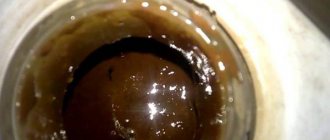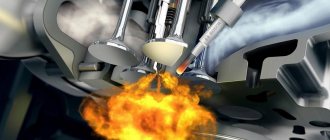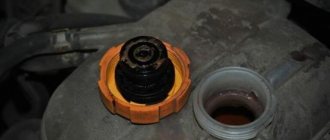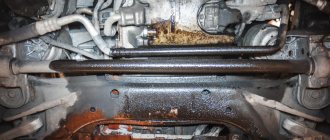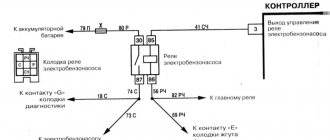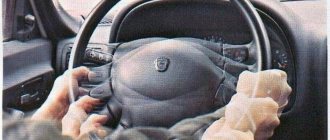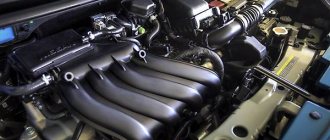The most common internal combustion engines are diesel and gasoline units.
As you know, gasoline engines appeared much earlier, but currently their popularity is falling. Increasingly, the choice of car enthusiasts falls on a diesel engine, and there is nothing unusual about this. Since diesel engines have a number of undoubted advantages:
- High level of efficiency;
- Has the best power characteristics;
- More economical;
- Relatively low price of fuel.
But these engines also have serious drawbacks, and one of them is an uncontrolled increase in engine speed. What does this mean, what does it threaten, why does diesel go to waste, and how to stop such an internal combustion engine? The causes of this destructive phenomenon, as well as ways to stop a diesel engine, will be discussed in our article.
Characteristic
Sometimes you hear “diesel has gone bad.” What does it mean? Overrun is an uncontrolled increase in engine crankshaft speed, regardless of the position of the accelerator pedal. In most cases, the driver cannot control this process. The crankshaft rotates at high speed, which is constantly increasing.
Sometimes the revs reach 5 thousand. This is dangerous for a diesel engine. This action occurs for several minutes. The result is a jammed power unit. Often accompanied by thick black smoke from the exhaust pipe.
Tray or delivery - which is correct?
During a normal conversation, you rarely pay attention to the speech culture of your interlocutor. You try more not to miss the meaning, to remember useful information
But when you write yourself, then you ask yourself the question: did you write it correctly? We, the employees of Merckx Team Ukraine, were forced to think about whether the words tray and delivery have the same or different meanings... work.
We specifically looked at several dictionaries authored by V. Dahl, D. Ushakov, S. Ozhegov, T. Efremova. Well-known linguists unanimously declare that the object on which we carry various dishes and drinks has one name - a tray!
Because the noun “tray” comes from the verb “to bring”
And it doesn’t matter whether you serve expensive dishes on it, treating (treating) visitors, or carry clean dishes around the hall, setting tables for a banquet
A board or sheet with curved edges, made of wood or metal, plastic or laminate, on which dishes are placed when carried, is always called only a tray.
The word “destruction” is very similar in sound, but, alas, does not in any way designate the object. It is an action or process. You can deliver packages and bills. A scolding is a strict, sharp reprimand from the authorities, from the parents. This can be a wide and shallow mine opening.
To be sure, we also looked into the Russian-English dictionary. “Carrying” is translated as “carrying” and means distribution (of mail), transportation (of cargo). “Tray” in English sounds like “a tray” and means an object. Those. Our waiter always carries a tray.
And so a work joke was born. If you bring the wrong dish on a tray, then you can get a dressing down from the client...
Reasons - fuel injection pump
One of the main reasons for this phenomenon is a malfunction of the high-pressure fuel pump or rack. As a result, fuel enters the combustion chamber without restrictions. This is an uncontrolled process. And the more of it gets into the chamber, the higher the engine speed. After this, the gas distribution mechanism (often with a chain drive) does not have time to react to these changes. As a result of incorrect phase distributions, the crankshaft, intake and exhaust valves bend. The consequences in most cases are very sad. What to do if the engine breaks down?
There is only one way to save the unit - shut it down. But it is not always possible to do this with a key. You have to independently block the access of air to the combustion chamber. But in some cases, the diameter of the inlet intake hole is very large. And even with improvised means it will not be possible to close it. Air will still flow through small cracks. It is worth noting that on passenger cars the oxygen intake is located at the bottom. Therefore, you will have to cut off the supply after the air filter. To do this, unscrew the clamp with a screwdriver and stop the oxygen supply to the pipe. This needs to be done as quickly as possible. Remember that minutes count here. The second option is longer, but effective. If the engine starts to spin, it is necessary to stop the fuel supply by disconnecting the fuel line. But there is not always time for this. The consequences are bent valves and a failed crankshaft. The worst thing is that at this time fragments of the cylinder block are flying. The explosion can be compared to the effect of a grenade. It is simply dangerous to be near such a motor. But this does not happen immediately, but after 3-5 minutes of engine operation in this mode.
What to do if the engine goes haywire: actions and reasons
Sometimes, while driving along a highway or city street, you can see an unusual sight: a truck, a road roller or a passenger car, barely visible through the clouds of smoke, spewing clouds of acrid fumes from the exhaust pipe with a heart-rending roar. An experienced driver will not be surprised when he notes: “The engine has gone haywire.”
Engine runaway is a serious problem that should be addressed immediately.
Why does the engine go into disarray?
Engine overrun is usually understood as a sharp and uncontrollable increase in speed to critical speed by the driver . This is especially dangerous while driving, since sudden and unexpected acceleration of the car can easily provoke an emergency. But even with a successful stop, a motor operating at maximum speed can easily be destroyed.
Overrun of a diesel engine is usually more dangerous than that of gasoline units. This is due to a different speed control mechanism:
- Gasoline engines have quantitative regulation : the driver, by changing the position of the throttle valve, regulates the resistance of the intake tract and, accordingly, the amount of a combustible mixture of a conditionally constant composition entering the engine. The pressure at the end of the compression stroke varies widely: from 12 bar with a sharp opening of the gas at low speeds to 1-2 bar when releasing gas at high speeds for a conventional engine like a VAZ;
- Diesel engines must have a constant high pressure in the cylinders (more than 20 bar) to ensure self-ignition of the injected fuel, so restricting the air supply is unacceptable for them and leads to engine shutdown. The speed is adjusted by the amount of fuel supplied, and, accordingly, by the quality of the mixture. This mechanism is called quality regulation .
Find out here how to illuminate the underbody of your car to avoid getting fined.
See here how much a taxi license costs and what is the procedure for obtaining it.
Thus, to sharply increase the speed of a gasoline engine, it is necessary to somehow quickly increase both the air supply and, accordingly, the fuel supply in order to maintain the ability of the fuel mixture to ignite from a spark. Agree, this is a difficult condition to fulfill. In addition, it is easy to turn off a gasoline engine by turning off the ignition (carburetor engines, of course, are capable of operating on glow ignition when the spark plug electrodes overheat, but this is a rarity and requires an extremely gross error in the selection of spark plugs).
To maintain the operation of an engine running on heavy fuel, no electrical circuits are needed , and even the path of fuel entering the cylinders is not important - this is why even modern diesel engines with Common Rail electronic injection can go into overdrive with the ignition off, when the injectors do not spray anything milligram of fuel. The composition of the fuel is also not important: a high degree of compression makes it possible to ignite the most seemingly unsuitable substances: the engines of old diesel locomotives in coal mines were blown apart even by the suspension of coal dust in the air due to ineffective air filters.
So we have come to the real reason why diesel engines go into overdrive and why it is difficult to turn them off: overrun occurs due to the spontaneous entry into the intake manifold of liquids capable of ignition in the engine cylinders, namely motor oil . At the same time, turning off the fuel supply (closing the electrovalve controlled by the ignition switch on old diesel engines or turning off the pump and injection computer on modern ones) does not stop the engine - while it is rotating, oil continues to flow into the intake... and it continues to rotate as long as oil flows. This closed cycle can only be interrupted by engine destruction from critically high speeds or oil starvation .
- Oil enters the intake manifold in two ways
: either through
the crankcase ventilation
(but to increase its removal in this way to critical values, a serious malfunction such as piston destruction is required), or through a
faulty turbocharger
.
The second option is the most common and dangerous: oil is supplied to the turbine under pressure, which means that through faulty seals it can enter the engine in such quantities that it will develop speeds that go far into the red zone of the tachometer. If the engine is not stopped in time, it will inevitably be destroyed due to the wedge of the connecting rod or main bearings
when the volume of engine oil is exhausted -
at high speeds this leads to breakage of the connecting rods, which can easily pierce the cylinder block
. In addition, oil accumulates in the intercooler - even if you stop the engine in time, the engine can go into meltdown again even after repairs if you forget to flush the intercooler.
Another reason for a diesel engine to go into overdrive can be a malfunction of the fuel injection pump on older cars with mechanical control - in this case, the engine stops slowing down when the gas pedal is released, but turning off the fuel supply stops it. This option, although no less unpleasant (injection pump repairs are quite expensive), does not have such destructive consequences.
Find out what the operating principle of a diesel engine is and what to do if the engine goes haywire (video)
How to stop a motor that has gone into overdrive?
For the first time, Soviet drivers encountered the addiction to diesel engines after the war, thanks to the widespread use of the YAZ-204 two-stroke diesel engine, copied from the American GMC engine of the late 30s. For almost forty years that it was on the assembly line, it was equipped with a wide variety of equipment: YaAZ (Yaroslavl Automobile Plant), ZIL and MAZ trucks, road rollers and even boats.
The two-stroke cycle on which this diesel unit operated required the use of a supercharger for forced purging of the cylinders. Its role was played by a powerful two-rotor Roots-type compressor, now often seen towering over the hoods of American tuned muscle cars. The low quality of the gear seals of the compressor gearbox (in those days, the rubber seals we were used to were exotic, their role was played by ineffective felt packings) often led to engine oil getting into the cylinders and causing the engine to run out.
The frequency of this phenomenon led to the fact that special emergency dampers were installed in front of the superchargers at the factory, designed to manually shut down the engine. This method is the only way to stop a runaway diesel engine - if it is impossible to stop the flow of fuel, all that remains is to block the air flow .
This is where the well-known driver's stories about Kamaz trucks that are capable of swallowing a sweatshirt come from - to stop a runaway engine, you need to stuff some dense fabric into the air intake; for truckers, often that same sweatshirt. Attempts to stop a large engine by squeezing the brakes while in gear often result in the engine, which has reached peak power, continuing to pull the car forward, burning out the clutch.
So, the procedure to follow if you lose control of the engine:
- If there is a sudden uncontrolled increase in engine speed, immediately turn off the gear and ignition , and, if possible, move to the side of the road.
- Turn on the hazard lights and open the hood if necessary to access the air intake.
- Cover the air intake with any available piece of dense material. Never attempt to close it with your hand, as this may result in serious injury! If you have a carbon dioxide fire extinguisher , point its nozzle into the air intake and open the tap - a powerful flow of non-flammable gas will cause the engine to choke and stop.
- The car can only be transported to the repair site by tow or tow truck: do not try to start it again !
As a rule, when stopped in a timely manner, a diesel engine that has gone into overdrive does not suffer damage (unless, of course, the reason for the oil entering the engine cylinders is the destruction of the piston) and after repairing or replacing the turbocharger, it can continue to be used without problems.
Bottom line
As already mentioned, a diesel engine not only does not need a throttle valve, it is even harmful to its operation. At the same time, many people familiar with the operating principles of diesel engines are surprised by its presence in modern cars with Common Rail injection, and this damper is only electrically controlled from the injection ECU.
In fact, its main purpose is to create a local vacuum zone in the intake manifold after the turbocharger enters operating mode for the correct operation of the exhaust gas recirculation (EGR) system. At the same time, when the ignition is turned off, it closes automatically, smoothly shutting down the engine without the “bouncing” characteristic of diesel engines with a mechanical fuel injection pump and protecting the engine from spinning out. Therefore, if your car is equipped with just such an engine, consider that this article for you was of an exclusively educational and not practical nature.
Add ProCrossovers to your favorites
Turbine
Diesel can go bad for a variety of reasons. If it is a turbocharged engine, there is a high probability that this happened precisely because of this mechanism. This element is cooled by oil. Sometimes leaks occur. As a result, the mechanism is unable to provide boost. Engine speed involuntarily increases. As they increase, the oil pump begins to pump lubricant faster. As a result, it ends up in the combustion chamber. Black smoke comes out of the exhaust pipe.
With such a malfunction, the unit may be left without lubrication altogether. After all, all the oil went into the exhaust pipe. There have been cases when, even after turning off the fuel supply, the unit continued to operate purely on lubricant. And even if this process lasts no more than a minute, this is quite enough for the diesel to go to waste. This happens especially often on older military engines. They are designed for the consumption of fuel oil and kerosene. Therefore, you should not be surprised that after stopping the fuel supply, the engine continues to work. If the diesel engine goes into overdrive, the crankshaft may burst in half. It is not necessary that it will tear out the cylinder block and fly out with fragments. In some cases, the engine will continue to operate, but with characteristic knocking noises. What else happens when diesel goes into overdrive? As the speed increases, the engine temperature increases. It overheats quickly. Also, if it is a leak from the turbine, fires are possible in the exhaust manifold area. Piston jamming occurs in a matter of minutes. Moreover, it does not matter what the current inertia force of the flywheel is. Even if the car is idling, the connecting rod bolts and other elements of the crank mechanism (crank mechanism) may break.
What are the dangers of running a diesel engine?
An engine that has gone into overdrive, first of all, poses a danger both to the driver and to everyone around him. Firstly, a fire may occur in the exhaust manifold due to a sharp increase in temperature and fuel particles entering it. Ignition of the manifold leads to the transfer of flame to the fuel tank, which is accompanied by an explosion of the latter.
Another danger is engine overheating. Typically, during the process of overheating, parts are deformed and dimensional accuracy is seriously compromised. Thus, they become dislodged and cause the motor to jam. In this case, expensive engine repairs cannot be avoided.
Usually, after a breakdown, a major overhaul of the engine always occurs. Although, there are often cases when after this the motor is completely beyond repair.
Why only diesels?
As practice shows, only the diesel engine is destroyed.
And there are reasons for this. The speed of a gasoline engine is controlled by the throttle valve. It passes a certain amount of air, as a result of which the number of shaft revolutions can be adjusted from 1 to 7 thousand. On gasoline motorcycle internal combustion engines, the maximum mark is 10-13 thousand. As for the diesel engine, its operation is controlled by the amount of fuel, not air. The design of such a unit does not have a throttle valve. Moreover, in order to ignite the mixture, it does not need candles or sparks. Even if you remove the battery, such a motor will continue to work. As for modern diesel engines, they have a much smaller chance of going into overdrive, since the amount of fuel is strictly dosed by injectors.
Here the system is controlled electronically, so if there are problems with the gas pedal, the computer will stop or partially reduce the supply of fuel to the combustion chamber. This usually takes less than a second. Thus, if the diesel goes into overdrive, you do not have to unscrew the fittings and lines yourself, or block the access to oxygen. The electronics will do everything for you, and so quickly that you won’t notice it.
What should you do after you have stopped the diesel engine?
Even when you did everything correctly and quickly stopped the engine, try NOT to START it again under any circumstances. If this problem catches you on the road, then park your car in a safe place, turn on the emergency lights and call a tow truck. You need to take the car to a car service center, where they will study the situation in detail and determine the cause of the illness.
Our video clip above clearly shows everything that can happen when an engine runs out of control, and also how some experienced motorists were able to stop an out of control engine. And friends, there is one more precaution that we want to inform you about, namely, if you try to stop the air supply to the engine directly through the turbocharger (as the American did and as shown in the second video), then please be extremely careful not to accidentally get your fingers into the turbine rotor!
Source
How to avoid malfunction?
To avoid serious consequences, you need to monitor the performance of the injection pump.
An engine equipped with a turbine or compressor should not squirt oil or “eat” it beyond normal limits. The limit is 1 liter per ten thousand kilometers. Timely oil changes and repairs to the cylinder-piston group can reduce the risk of blowout several times. Remember that if the seal is broken, oil will enter the intake tract along with air. This mixture burns much more intensely. Therefore, the turnover will increase. And so on until the oil is completely gone. Crankcase ventilation should also be monitored. If it is poorly sealed, oil vapors enter the intake manifold. When the car's mileage is high, the piston rings are not able to remove all the film. As a result, vapors under pressure from the crankcase penetrate into the combustion chamber. It is impossible to control this process.
Diagnostics of diesel internal combustion engines
As mentioned earlier, the engine can spin out immediately after starting or after a sharp reduction in load. You can diagnose the malfunction using the tachometer: the idle speed will not be at a normal level. In addition, a sharp engine hum will appear, accompanied by increased emissions of black exhaust smoke.
As for driving in gear, the car will begin to pick up speed very quickly on its own. It is worth saying here that this behavior of the machine is extremely dangerous, and therefore it is necessary to take quick and decisive measures.
First of all, put the car in neutral and stop the car on the side of the road. It will be better if it is a deserted place so as not to pose a danger to others. Next you need to stop the engine. If the engine has gone into overdrive, then it will not be possible to do this in the usual way, so you need to get out of the car and forcefully turn off the engine. To do this, you can cut the fuel pipes. Thus, the fuel supply will stop and the engine will stop. The pipes are located on the gas tank or fuel rail under the hood. Which ones to chop is your choice, but it should be based on the speed of your actions.
Another way is “oxygen starvation.” It is necessary to remove the air filter, or without removing it, plug the air pipe with thick fabric or any other material. Thus, air will stop flowing into the combustion chamber and the engine will stop. Further movement is possible only in tow. Unfortunately, it is impossible to move on such an engine.
Additional pump adjustment
If diagnostics of diesel engines shows that the mixture is not being prepared correctly, most likely the cause is the injection pump, and the centrifugal regulator cannot cope with this function. For this, a special adjustment stand is used.
Before checking, it is necessary to clean the pump from dirt and other deposits. Then the injection advance is checked using marks and the low pressure valve is diagnosed. To do this, you need to unscrew the valve and tap with a hammer (light blows) on its upper part. Next, the cyclic feed is set. It is adjusted using a locknut. If necessary, it is unscrewed or tightened and then clamped. Normal idle speed of a diesel engine is 770-790 per minute. For additional adjustment, use a hydraulic corrector by rotating its rod counterclockwise or clockwise. Timely troubleshooting ensures reliable operation of the power system and the engine as a whole.
Runaway hazard for diesel vehicles
In the cylinders of diesel engines, the pressure must always be constant and sufficiently high. And be at least 20 bar. This pressure is necessary so that when fuel is injected, it ignites spontaneously. If there is a problem with the air supply, the engine stops running.
The operation of a diesel engine is based on the principle of quality control, that is, speed control is carried out using a normal amount of supplied fuel, and with a high quality of the fuel itself.
In diesel cars, the engine can go into overdrive even when the ignition is turned off, when the injectors do not spray fuel even in minimal doses.
Tags
diesel engines diesel engine.diesel engine.engine speed.Diagnostics of diesel engines are diesel and drops. Diesel engines of a diesel engine. for a diesel engine. only a diesel engine. of each diesel unit. diagnostics of diesel engines diesel engine speed Diesel engines more so that the engine matches such a motor just fuel the motor continues in cases the motor will be such a motor will be if the motor has become gasoline engines have appeared
articlesAvtorVAZ
